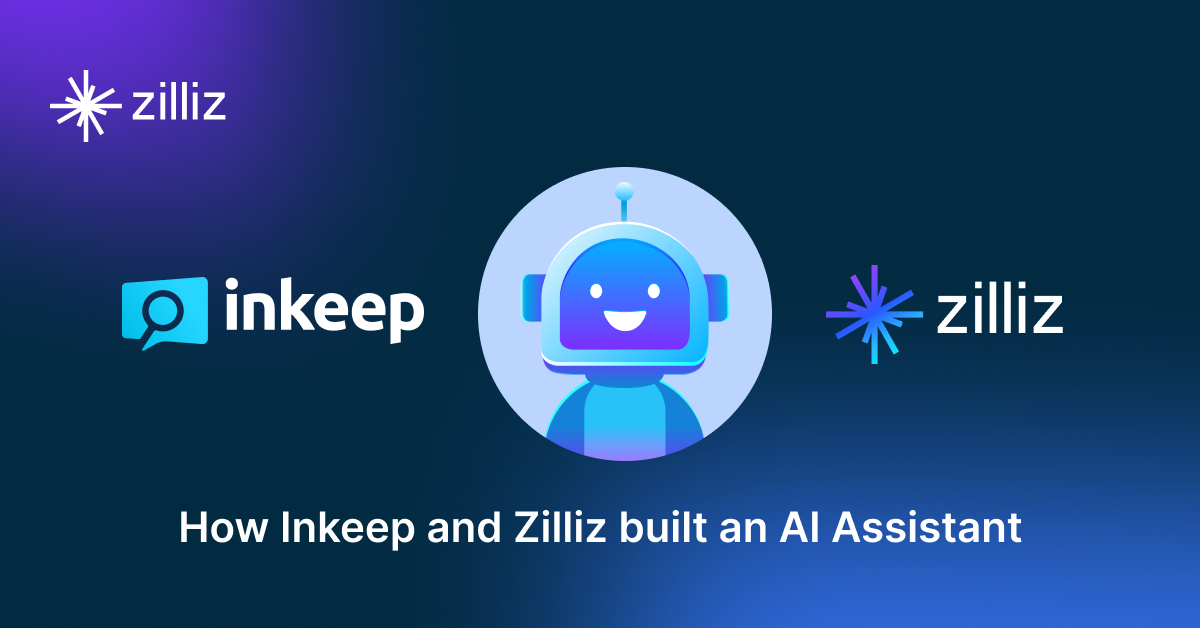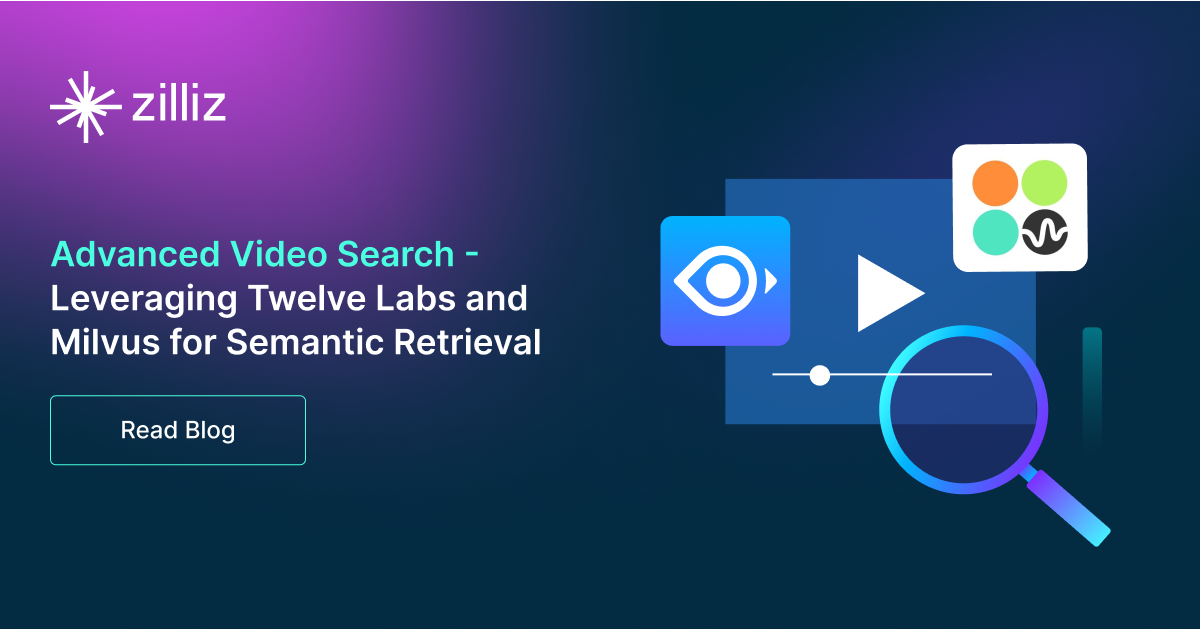Build RAG Chatbot with Llamaindex, HNSWlib, Databricks DBRX, and jina-clip-v1
Introduction to RAG
Retrieval-Augmented Generation (RAG) is a game-changer for GenAI applications, especially in conversational AI. It combines the power of pre-trained large language models (LLMs) like OpenAI’s GPT with external knowledge sources stored in vector databases such as Milvus and Zilliz Cloud, allowing for more accurate, contextually relevant, and up-to-date response generation. A RAG pipeline usually consists of four basic components: a vector database, an embedding model, an LLM, and a framework.
Key Components We'll Use for This RAG Chatbot
This tutorial shows you how to build a simple RAG chatbot in Python using the following components:
- Llamaindex: a data framework that connects large language models (LLMs) with various data sources, enabling efficient retrieval-augmented generation (RAG). It helps structure, index, and query private or external data, optimizing LLM applications for search, chatbots, and analytics.
- HNSWlib: a high-performance C++ and Python library for approximate nearest neighbor (ANN) search using the Hierarchical Navigable Small World (HNSW) algorithm. It provides fast, scalable, and efficient similarity search in high-dimensional spaces, making it ideal for vector databases and AI applications.
- Databricks DBRX: DBRX is a transformer-based decoder-only large language model (LLM) that was trained using next-token prediction. It uses a fine-grained mixture-of-experts (MoE) architecture with 132B total parameters of which 36B parameters are active on any input. It was pre-trained on 12T tokens of text and code data.
- Jina-CLIP-V1: A multimodal AI model that bridges text and images via shared embeddings, enabling cross-modal retrieval and understanding. Strengths include robust generalization, efficient scalability, and seamless integration for multilingual and visual-text tasks. Ideal for image-text search, content recommendation, and enhancing AI-driven applications in e-commerce, media, and digital asset management.
By the end of this tutorial, you’ll have a functional chatbot capable of answering questions based on a custom knowledge base.
Note: Since we may use proprietary models in our tutorials, make sure you have the required API key beforehand.
Step 1: Install and Set Up Llamaindex
pip install llama-index
Step 2: Install and Set Up Databricks DBRX
% pip install llama-index-llms-databricks
from llama_index.llms.databricks import Databricks
llm = Databricks(
model="databricks-dbrx-instruct",
api_key="your_api_key",
api_base="https://[your-work-space].cloud.databricks.com/serving-endpoints/",
)
Step 3: Install and Set Up jina-clip-v1
%pip install llama-index-embeddings-jinaai
You may also need other packages that do not come direcly with llama-index.
!pip install Pillow
from llama_index.embeddings.jinaai import JinaEmbedding
embed_model = JinaEmbedding(
api_key=jinaai_api_key,
model="jina-clip-v1",
# choose `retrieval.passage` to get passage embeddings
task="retrieval.passage",
)
Step 4: Install and Set Up HNSWlib
%pip install llama-index-vector-stores-hnswlib
from llama_index.vector_stores.hnswlib import HnswlibVectorStore
from llama_index.core import (
VectorStoreIndex,
StorageContext,
SimpleDirectoryReader,
)
vector_store = HnswlibVectorStore.from_params(
space="ip",
dimension=embed_model._model.get_sentence_embedding_dimension(),
max_elements=1000,
)
Step 5: Build a RAG Chatbot
Now that you’ve set up all components, let’s start to build a simple chatbot. We’ll use the Milvus introduction doc as a private knowledge base. You can replace it with your own dataset to customize your RAG chatbot.
import requests
from llama_index.core import SimpleDirectoryReader
# load documents
url = 'https://raw.githubusercontent.com/milvus-io/milvus-docs/refs/heads/v2.5.x/site/en/about/overview.md'
example_file = 'example_file.md' # You can replace it with your own file paths.
response = requests.get(url)
with open(example_file, 'wb') as f:
f.write(response.content)
documents = SimpleDirectoryReader(
input_files=[example_file]
).load_data()
print("Document ID:", documents[0].doc_id)
storage_context = StorageContext.from_defaults(vector_store=vector_store)
index = VectorStoreIndex.from_documents(
documents, storage_context=storage_context, embed_model=embed_model
)
query_engine = index.as_query_engine(llm=llm)
res = query_engine.query("What is Milvus?") # You can replace it with your own question.
print(res)
Example output
Milvus is a high-performance, highly scalable vector database designed to operate efficiently across various environments, from personal laptops to large-scale distributed systems. It is available as both open-source software and a cloud service. Milvus excels in managing unstructured data by converting it into numerical vectors through embeddings, which facilitates fast and scalable searches and analytics. The database supports a wide range of data types and offers robust data modeling capabilities, allowing users to organize their data effectively. Additionally, Milvus provides multiple deployment options, including a lightweight version for quick prototyping and a distributed version for handling massive data scales.
Optimization Tips
As you build your RAG system, optimization is key to ensuring peak performance and efficiency. While setting up the components is an essential first step, fine-tuning each one will help you create a solution that works even better and scales seamlessly. In this section, we’ll share some practical tips for optimizing all these components, giving you the edge to build smarter, faster, and more responsive RAG applications.
LlamaIndex optimization tips
To optimize LlamaIndex for a Retrieval-Augmented Generation (RAG) setup, structure your data efficiently using hierarchical indices like tree-based or keyword-table indices for faster retrieval. Use embeddings that align with your use case to improve search relevance. Fine-tune chunk sizes to balance context length and retrieval precision. Enable caching for frequently accessed queries to enhance performance. Optimize metadata filtering to reduce unnecessary search space and improve speed. If using vector databases, ensure indexing strategies align with your query patterns. Implement async processing to handle large-scale document ingestion efficiently. Regularly monitor query performance and adjust indexing parameters as needed for optimal results.
HNSWlib optimization tips
To optimize HNSWlib for a Retrieval-Augmented Generation (RAG) setup, fine-tune the M parameter (number of connections per node) to balance accuracy and memory usage—higher values improve recall but increase indexing time. Adjust ef_construction (search depth during indexing) to enhance retrieval quality. During queries, set ef_search dynamically based on latency vs. accuracy trade-offs. Use multi-threading for faster indexing and querying. Ensure vectors are properly normalized for consistent similarity comparisons. If working with large datasets, periodically rebuild the index to maintain efficiency. Store the index on disk and load it efficiently for persistence in production environments. Monitor query performance and tweak parameters to achieve optimal speed-recall balance.
Databricks DBRX optimization tips
To optimize Databricks DBRX in a Retrieval-Augmented Generation (RAG) setup, focus on efficiently integrating DBRX with your vector store for seamless retrieval and real-time document processing. Leverage the platform’s scalability by partitioning large datasets and using optimized cluster configurations to handle intensive tasks. Ensure your embeddings are stored in the most efficient format, and use indexing techniques like HNSW or IVF for faster retrieval. Optimize Spark jobs by fine-tuning resource allocation, minimizing shuffle operations, and utilizing caching to reduce query latency. Finally, monitor and adjust the job execution plan to avoid unnecessary overhead, ensuring optimal performance while maintaining cost efficiency.
Jina-CLIP-v1 optimization tips
To optimize Jina-CLIP-v1 in a RAG setup, preprocess inputs by normalizing text and resizing images to match the model’s expected dimensions (e.g., 224x224). Use batch inference to maximize GPU utilization and enable mixed-precision (FP16) for faster processing. Fine-tune the model on domain-specific data to improve retrieval relevance. Cache frequently accessed embeddings to reduce redundant computations. Optimize vector indexing with approximate nearest neighbor (ANN) libraries like FAISS or HNSW for efficient similarity search. Regularly validate embedding quality using downstream task metrics to ensure alignment with retrieval goals.
By implementing these tips across your components, you'll be able to enhance the performance and functionality of your RAG system, ensuring it’s optimized for both speed and accuracy. Keep testing, iterating, and refining your setup to stay ahead in the ever-evolving world of AI development.
RAG Cost Calculator: A Free Tool to Calculate Your Cost in Seconds
Estimating the cost of a Retrieval-Augmented Generation (RAG) pipeline involves analyzing expenses across vector storage, compute resources, and API usage. Key cost drivers include vector database queries, embedding generation, and LLM inference.
RAG Cost Calculator is a free tool that quickly estimates the cost of building a RAG pipeline, including chunking, embedding, vector storage/search, and LLM generation. It also helps you identify cost-saving opportunities and achieve up to 10x cost reduction on vector databases with the serverless option.
 Calculate your RAG cost
Calculate your RAG cost
What Have You Learned?
Congratulations on making it through this tutorial! You've taken significant strides in understanding how to create a powerful Retrieval-Augmented Generation (RAG) system by integrating four critical components: a robust framework, a vector database, a language model, and an embedding model. By leveraging LlamaIndex for your comprehensive framework, you learned how to structure and manage your data effectively. Then, diving into the capabilities of HNSWlib as your vector database showed you the magic of efficient data retrieval. With Databricks DBRX, you harnessed the potential of Large Language Models (LLMs) to generate meaningful responses, and finally, utilizing the jina-clip-v1 embedding model enabled you to create enriched representations of your data. By bringing these elements together, you've unlocked a treasure trove of possibilities for building innovative applications that truly understand and respond to user needs!
Throughout the tutorial, we also highlighted some essential optimization tips to enhance your RAG system's performance—such as fine-tuning your embedding model for better contextual understanding and making clever use of caching mechanisms for speedy queries. Plus, the complimentary RAG cost calculator will help you estimate and plan your project budget effectively. Armed with this knowledge, you now have all the tools you need to start building, optimizing, and innovating your very own RAG applications! So don’t hold back—get out there and unleash your creativity! The future is bright, and we can’t wait to see what amazing solutions you’ll come up with next!
Further Resources
🌟 In addition to this RAG tutorial, unleash your full potential with these incredible resources to level up your RAG skills.
- How to Build a Multimodal RAG | Documentation
- How to Enhance the Performance of Your RAG Pipeline
- Graph RAG with Milvus | Documentation
- How to Evaluate RAG Applications - Zilliz Learn
- Generative AI Resource Hub | Zilliz
We'd Love to Hear What You Think!
We’d love to hear your thoughts! 🌟 Leave your questions or comments below or join our vibrant Milvus Discord community to share your experiences, ask questions, or connect with thousands of AI enthusiasts. Your journey matters to us!
If you like this tutorial, show your support by giving our Milvus GitHub repo a star ⭐—it means the world to us and inspires us to keep creating! 💖
- Introduction to RAG
- Key Components We'll Use for This RAG Chatbot
- Step 1: Install and Set Up Llamaindex
- Step 2: Install and Set Up Databricks DBRX
- Step 3: Install and Set Up jina-clip-v1
- Step 4: Install and Set Up HNSWlib
- Step 5: Build a RAG Chatbot
- Optimization Tips
- RAG Cost Calculator: A Free Tool to Calculate Your Cost in Seconds
- What Have You Learned?
- Further Resources
- We'd Love to Hear What You Think!
Content
Vector Database at Scale
Zilliz Cloud is a fully-managed vector database built for scale, perfect for your RAG apps.
Try Zilliz Cloud for Free


